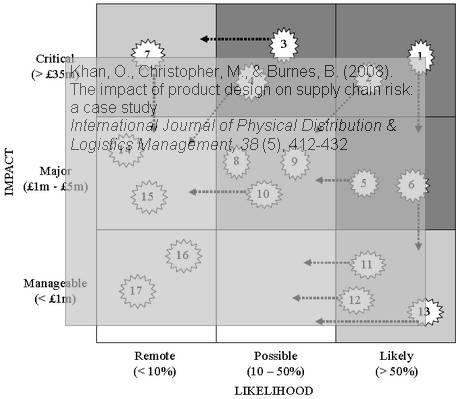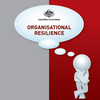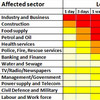 Is it possible that supply chain risk is a result of unfortunate product design? Is it possible that supply chain risk does not only relate to the supply chain itself, but just as much to what is in the supply chain? What is in the supply chain is determined by a design process, and consequently, is it possible to design supply chain risk out of (or in to) the supply chain? In Khan, Christopher & Burnes (2008) The impact of product design on supply chain risk: a case study, that is the question that is sought answered.
Is it possible that supply chain risk is a result of unfortunate product design? Is it possible that supply chain risk does not only relate to the supply chain itself, but just as much to what is in the supply chain? What is in the supply chain is determined by a design process, and consequently, is it possible to design supply chain risk out of (or in to) the supply chain? In Khan, Christopher & Burnes (2008) The impact of product design on supply chain risk: a case study, that is the question that is sought answered.
Omera Khan
A month ago I wrote a post referencing an article by Christopher, Burnes & Khan (2007) Risk and Supply Chain Management – Creating a Research Agenda, that prompted a comment by Omera Khan herself, offering to send me more details on her related research. Today’s post is a result of our brief e-mail exchange, and I plan to feature more articles by Omera Khan in the near future.
Short life cycles – increased supply chain risk
While previously it was the fashion and clothing industry that set the trends (often well ahead of the upcoming season), now, more often than not, the consumers set the trends (and thus the life cycle length of a clothing item), not the industry. In consequence, the industry needs to develop a certain agility and responsiveness towards what is hot and in demand.
The co-ordination of activities along the supply chain has extensively been focused on the efficiency along the value chain, but surprisingly, a major issue, the design of the product and how it is co-ordinated, managed and its impact to the supply chain has largely been ignored. With customers increasingly demanding greater variety in products at lower costs, design has become an important means by which companies can gain a competitive advantage in their supply chains. For example, the design of products has a huge impact not only on market success, but also on the sourcing of components, production, distribution and even on how final products will be displayed to customers in retail.
The long lead times that come from outsourcing production (and often design as well) are often counterproductive to taking the lead in a highly competitive market. What is hot is hot now, not in two months when your item may be available, and what may be hot in two months (when you plan your supply chain), may not be so hot after all, two months from now.
Outsourcing – increased supply chain risk
In the clothing and fashion industry, trend cycles (and product cycles) are short, so matching demand with supply is essential, and both supply-side risk and demand-side risks are important elements in managing supply chain risk. The UK clothing retailer Marks & Spencer (M&S) learned its lesson the hard way, but has bounced back after it realized how crucial product design is in supply chain risk:
Designing product ranges in-house as opposed to using external designers and consultants enables M&S’s product development team to influence the supply chain both upstream and downstream as sales information and feedback from customers is received. It also minimises the risk of outsourcing design to external designers who may design products that are incongruent with product ranges designed by in-house designers. By designing in-house, designers from different clothing segments can communicate ideas and compare the trends for the collections much more quickly and can identify if products across all segments will sit together as a complete collection in stores
It is obvious that in industries such as clothing, textile and fashion, design cannot be not an isolated function but is in fact a critical process that impacts the total supply chain. Design, however, is not everything.
Agility and design
Pairing design with agility is one way (if not THE way) to reduce supply chain risk. This means making the right decisions early at the design stage, thus allowing later design changes or adaptations, resulting in products with maximum flexibility for insertion into changing markets. Design is then the platform on which the effectiveness of the total supply chain rests.
Therefore, a key challenge facing organisations in which design is a critical function, such as the textile and clothing industries, is to integrate design and supply chain management in order to effectively meet customer needs and manage supply chain risk. Failure to do so could create problems at the manufacturing or logistics stages in the supply chain and thus, increase the risk of supply chain disruption.
It follows then that if design, not cost, should take the lead in working with suppliers.
Marks & Spencer
Using Marks & Spencer (M&S) in their case study, Khan, Christopher and Burnes examine the role that design can play in managing risk in the clothing and textile industries in an increasingly global supply chain. Using a traditional risk matrix, 17 risks were identified and plotted for improvement.

What M&S learned is that design needs to be kept in-house as a core competence, and that the product development process needs to be more agile, particularly through increased communication and collaboration in the supply chain.
Conclusion
The paper does make a strong argument for viewing design decisions as highly important supply chain decisions. As they put it, “the supply chain begins on the drawing board”. It couldn’t be more true than that. After the drawing board it is too late, well, not really, but it certainly takes a lot more effort.
How product personalization affects supply network design
On a side note, on Daniel Stengel’s SCRMBlog I found a review of Poulin et al. (2006) and their view on the various types of personalization of products and how that affects supply network design.
Reference
Khan, O., Christopher, M., & Burnes, B. (2008). The impact of product design on supply chain risk: a case study International Journal of Physical Distribution & Logistics Management, 38 (5), 412-432 DOI: 10.1108/09600030810882834
Links
- martin-christopher.info: Martin Christopher’s home page
- manchester.ac.uk: Bernard Burnes‘ homepage
- linkedin.com: Omera Khan
Related
- husdal.com: Lean + Agile = LeAgile: A happy marriage?
- husdal.com: Risk and Supply Chain Management – Creating a Research Agenda












